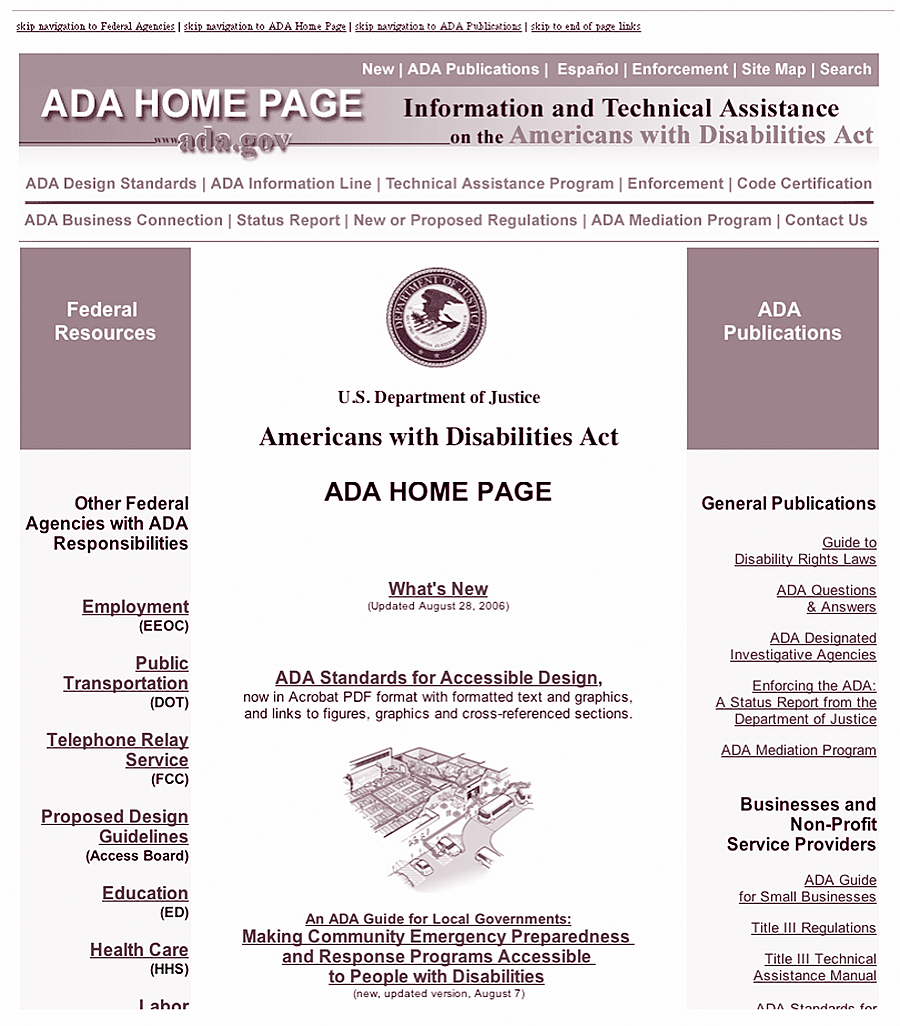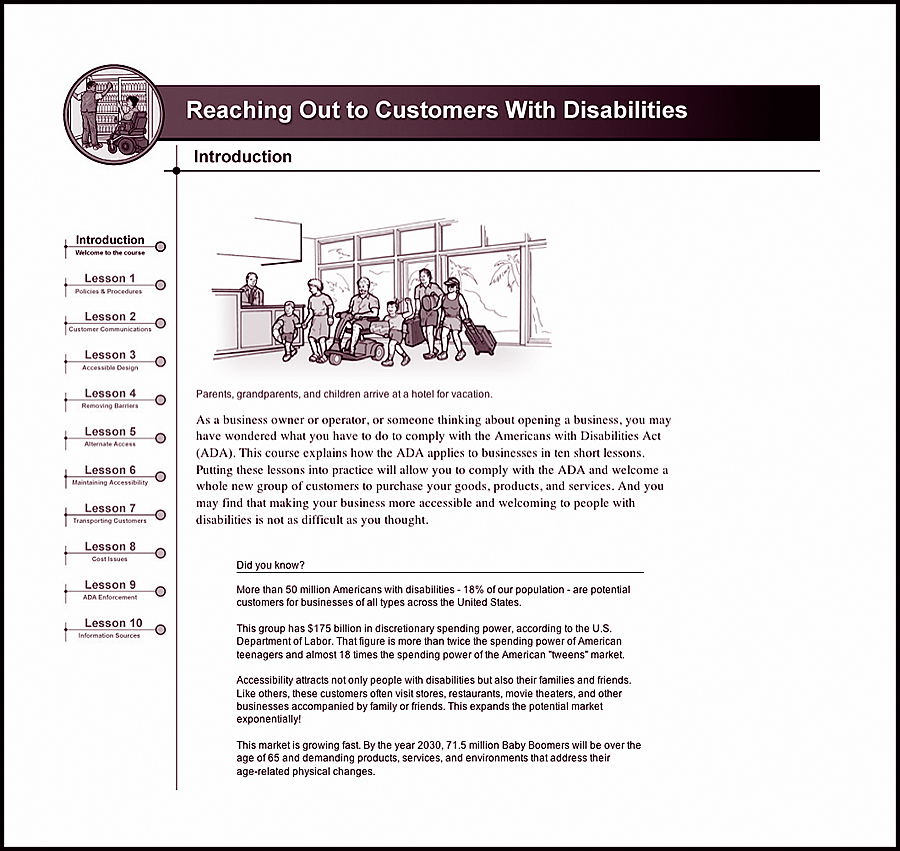| V. PROVIDING TECHNICAL ASSISTANCE "But I don't understand why the law says I have to keep 18" of clear space on the latch side of the door. It doesn't make sense." "Nobody with a disability ever comes in here, so why do I have to do anything?" "This is a restaurant and we don't allow pets. Now there's a woman in here and she says I have to let her in with her guide dog." The ADA is the first civil rights law to require the government to help people and organizations understand their rights and responsibilities under the law. And that is no small task: the ADA covers more than seven million businesses, more than 80,000 units of state and local government, and over 50 million people with disabilities. To accomplish this seemingly daunting task, the Department engages in a wide range of activities to foster understanding of, and voluntary compliance with, the ADA. Those activities include providing a vast array of technical assistance materials; maintaining the popular ADA Website; offering a nationwide, toll-free ADA Information Line; running the ADA Business Connection; and conducting outreach initiatives to reach businesses, state and local governments, and people with disabilities. Below, we describe some of the individual components of the Department's Technical Assistance program. Every component shares one common goal: to provide accurate, understandable, and timely information to people across the country in the manner that best meets their individual needs. A. ADA Information Line
B. ADA Website The popular ADA Website (www.ada.gov) provides direct access to the Department's ADA publications, briefs, and settlement agreements as well as to general information about the Department's enforcement, mediation, technical assistance, and certification programs. The site also includes information about any proposed changes in ADA regulations and requirements, links to ADA press releases, and links to other federal agencies' websites that contain ADA information.The easy-to-remember address has become one of the Department's five most-viewed web pages. The website served more than 2.6 million visitors in fiscal year 2005; those visitors viewed the pages and images on the site more than 37 million times, a 218 percent increase from fiscal year 2001. In fiscal year 2005, the Department added to the ADA Website Reaching Out to Customers with Disabilities, an interactive, online course that explains the ADA and how it applies to businesses.144 The course condenses hundreds of pages of regulations, technical guidance, and Department policy into a product that is easy to use and understand. The course is in an accessible format that can be used by people who are blind or have low vision. Using streaming video technology, the Department has also added three fully accessible streaming videos to the ADA Website in the past two years. Ten Small Business Mistakes145 features statements by store owners expressing their doubts or misunderstandings about the ADA followed by responses from Department officials and staff explaining the law in common sense terms. Police Response to People with Disabilities146 addresses law enforcement situations involving people who have mobility, speech, hearing, or vision disabilities, as well as people who have mental illnesses, mental retardation, or seizure disorders. The ADA Signing Ceremony147 documents the speech given by Pres-ident George H. W. Bush when he signed the ADA into law on July 26, 1990. Copies of these videos can be ordered through the ADA Information Line or the ADA Website. C. The ADA Business Connection The ADA Business Connection is a multifaceted Department initiative that aims to improve access to everyday commerce by fostering dialogue and cooperation between the business community and the disability community. The ADA Business Connection has two main components: meetings and ongoing technical assistance for small businesses. Since 2001, more than 640 participants from small and mid-sized businesses, large corporations, and organizations of people with disabilities have attended 16 dynamic ADA Business Connection Leadership meetings in cities across the United States. The sessions presented speakers from multinational companies, local businesses, and individuals with disabilities, who spoke about building business cases for accessible products and services, providing staff training, hiring employees with disabilities, and honing effective marketing techniques. These meetings have sparked lively and productive discussions, as well as promising collaborations between the business and disability communities. Some examples of the positive responses to the presentations include:
"The ADA Business Connection is a great thing. The meetings are important for maintaining connection to the issues and the people; the biggest value of the meeting is the communication." - A business representative who attended a 2002 Business Connection meeting in Washington, D.C. The ADA Business Connection has also produced a variety of compliance assistance materials addressing issues of specific interest to small businesses. Since 2001, the program has produced five ADA Business Briefs – short documents explaining specific ADA issues that are designed to be easily printed and distributed to employees. Topics addressed include service animals, restriping parking lots, providing assistance at gas stations, and effectively communicating in hotel and hospital settings with people who are deaf or hard of hearing. The program also produced Expanding Your Market, a series of documents providing demographic and topical information specifically tailored to each of the meeting locations, identifying people with disabilities as a largely untapped market of customers and potential employees. In addition, the program maintains the ADA Business Connection destination on the ADA Website.148 This web location houses the publications mentioned above, as well as Reaching Out to Customers with Disabilities, a fully accessible interactive online course that explains the ADA and how it applies to businesses in ten lessons. Also available on the ADA website is a streaming video of 10 Small Business Mistakes, a 13-minute video that identifies common mistakes that small businesses make when trying to comply with the ADA.149 Footnotes 144 U.S. Dep't of Justice, Reaching Out to Customers With Disabilities, available at http://www.ada.gov/ 145 U.S. Dep't of Justice, ADA Streaming Video Gallery, available at http://www.ada.gov/videogallery.htm. 146 Id. 147 Id. 148 U.S. Dep't of Justice, ADA Business Connection, available at http://www.ada.gov/business.htm. 149 U.S. Dep't of Justice, ADA Video Gallery, available at http://www.ada.gov/videogallery.htm. |
Back to Table of Contents



